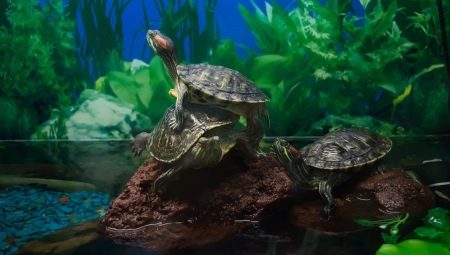Turtles are amazing river or water centenarians that are now found not only in their natural habitat, but also in apartments and houses. Aquarium creatures need special care and, of course, in the right neighborhood.
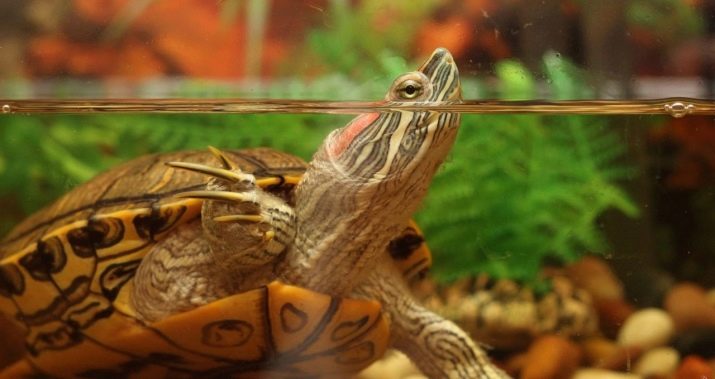
Kinds
The more popular inhabitants of home aquariums are, of course, small turtles. You can buy them at any zoological store. The best option for beginning breeders is dwarf individuals that do not require huge costs for their maintenance. Such a mini-turtle grows up to 13 centimeters in length, so it will live in peace in any aquarium. It is worth noting the most suitable turtles suitable for living in an aquarium.

Musky
This is the smallest representative among all turtles. The body length of an adult is not more than 14 centimeters. The average shell size does not exceed 7 centimeters. The main feature of such turtles is its very long neck.
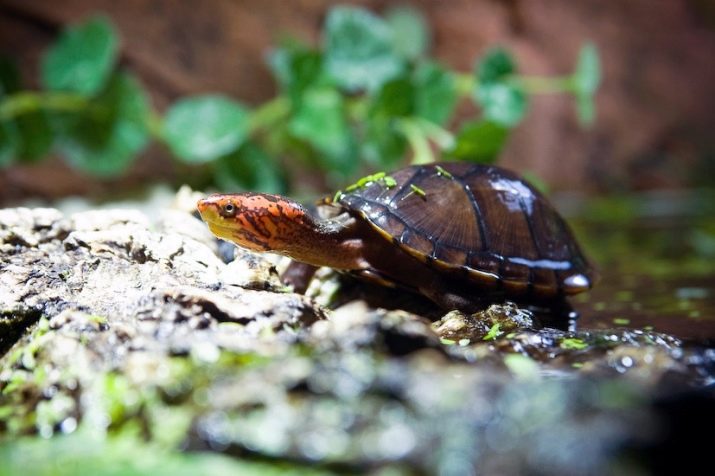
Thanks to this flexible turtle can easily reach its hind legs.
The carapace of such a reptile is quite smooth, with a uniform color. However, at a very young age, three distinct furrows appear on it. The natural habitat of turtles are water bodies with freshwater, as well as with a muddy bottom. They spend more than half of their lives in water.
In terms of keeping in the aquarium, these are the most unpretentious individuals. Thanks to this, they have become so popular. They got their name due to the fact that after a certain period of time a specific smell emanates from them. Most often this happens when water reptiles get scared.
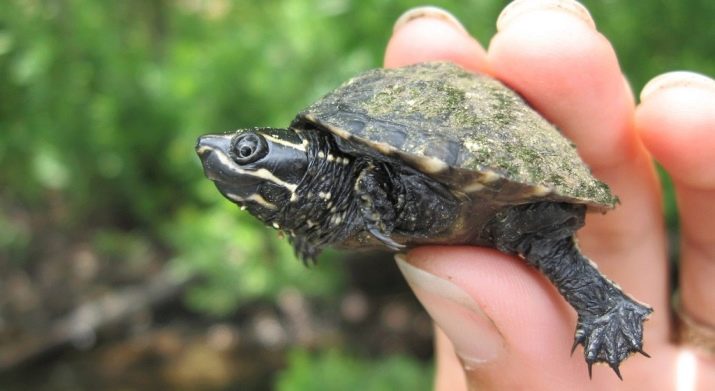
Spotted
Such water turtles are too common among aquarium lovers. You can recognize them by small yellow spots, which are located on the shell. In addition, they can also be seen on the neck, and on the head, and on the legs. The length of their body does not exceed more than 12 centimeters. The carapace on the abdomen is colored yellow. With a lot of black spots. In the natural environment they live in marshy areas.
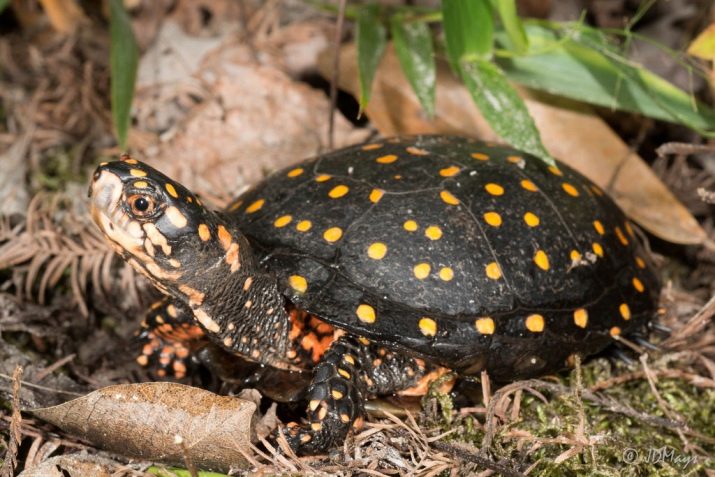
Flat
Tortoises with snake necks should include flat marine reptiles. The length of their body does not exceed 15 centimeters. However, rare individuals with a body length of up to 18 centimeters are found. Such marine inhabitants differ from their counterparts by the presence of a beautiful yellow-orange pattern on their heads. Outwardly, it resembles a crown.
The carapace is painted in a dark brown color, besides it has a yellow fringing. The neck is covered with small spines. The paws and tail of the reptile are dark in color, which against the background of the motley color of the body looks quite interesting. In addition, flat turtles have antennae.
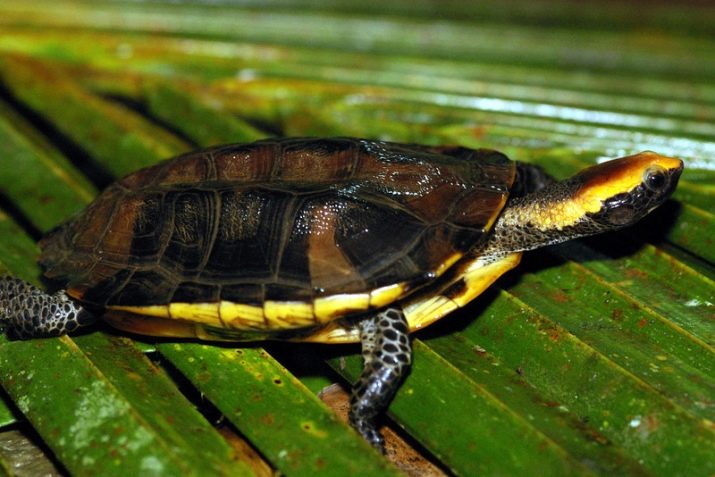
Among all reptiles, these turtles are the calmest. Their calmness can be disturbed except during the mating season.
Pond
This subspecies of turtles is very common in zoological stores. The body length of such reptiles does not exceed more than 13 centimeters, which makes it possible to keep in aquariums. Reeves pond turtles can have a different color: black, brown-yellow and dark brown. The neck and paws are most often completely black or gray-green, with white lines on both sides. In addition, they have a rather peaceful character.
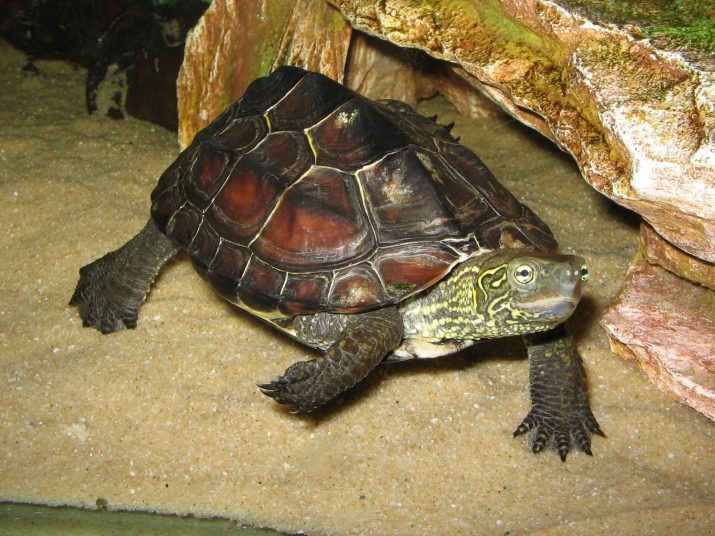
They are found mainly in Japan or China, on clay or sandbanks.
In addition to these floating turtles, it is worth noting a few more interesting individuals.
- Fringed reptilewhich can weigh up to 15 kilograms. To create such an aquarium, you need to buy at least 250 liters.
- Pond slider refers to medium-sized reptiles and can grow up to 30 centimeters in length. The shell is bright green. The neck, head and paws have a pattern in the form of green or white stripes.
- Chinese trionics weighs up to 5 kilograms with an increase of 35-40 centimeters. The carapace of such a reptile is more like a pan. Its upper side is painted gray-green. The rest of the body is brownish-green.
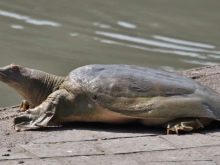
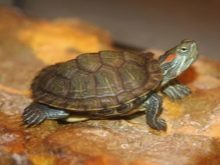
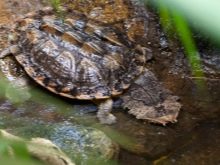
Content Rules
It is very important to properly care for such reptiles. First of all, in the aquariums there must be a substrate, which must necessarily include coarse sand and fine gravel or ordinary land that does not contain any additives. You can feed your pets with different products, as they are not too demanding on food. For this, products such as:
- vegetables - cucumbers or zucchini;
- fruits - for example, apples or pears;
- seafood - squid, shrimp or even fish of low-fat varieties;
- meat - it can be both raw and boiled;
- different greens - for example, mint or dandelion leaves, clover or alfalfa;
- you can use worms, locusts or crickets;
- cereals - for example, wheat or sunflower seeds.

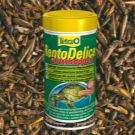




Do not forget about mineral supplements, egg shells, bone meal or shell rock. In addition, branches of apple or pear must be present in the diet, which animals can eat. Otherwise, their jaw may become deformed. Before starting a meal, the turtle must be warm. So the digestion process will occur much faster.
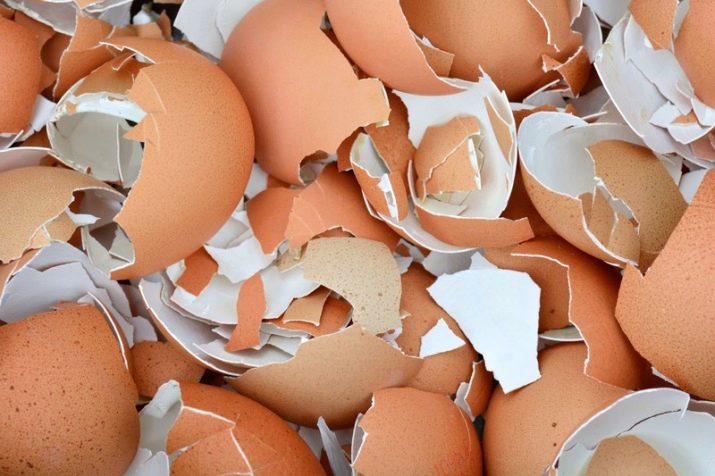
Some owners try to feed their pets with dry food. However, experts do not recommend doing this, since it is better to give turtles only natural food. It is also important to ensure that no food remains are left in the water. They must be removed immediately. Otherwise, the water quickly becomes cloudy.
Keeping domestic reptiles necessary in a container the size of which will be at least 5-6 times larger than the size of the turtle itself. The best option is a 150 liter aquarium.Pour water into it quite a lot. When the pet grows up, its level must be gradually increased. The water temperature should be at least 25 degrees. If the pet is crawling around the apartment, then the room should also be warm.
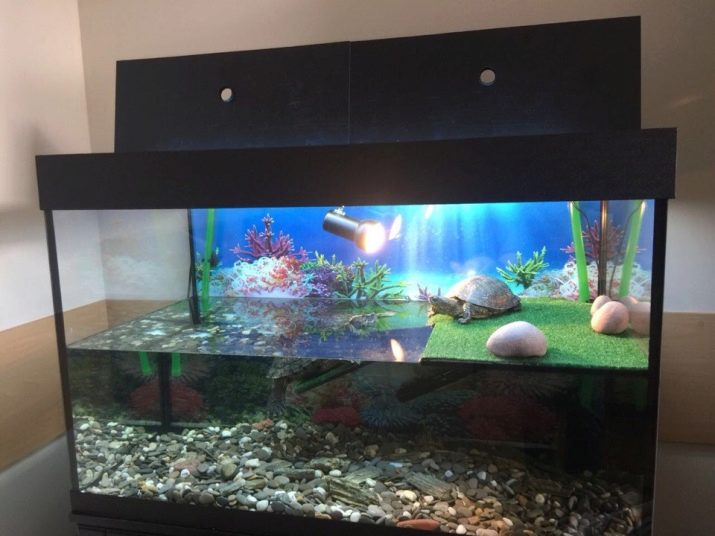
The temperature there should be no lower than +28 degrees.
Tortoise care also includes regular cleaning of the aquarium. Change the water at least once a week, which takes no more than half an hour. For an aquarium, it is best to use well-filtered water. On the surface of the aquarium you can leave living plants, which will also be an excellent food for turtles. But a bowl of food at the bottom of the aquarium should not be left. It is best placed outside the tank.
Turtles usually live in an aquarium, but often try to get out of it. Therefore, you need to occasionally take them out and take them out for a while, which will allow reptiles to always be in a good mood and maintain health for a very long time. At a distance of 1.5 meters from the aquarium, you must install an ultraviolet lamp. Small reptiles need to include it no more than 5 minutes twice a week. Then the lighting time should be gradually increased.
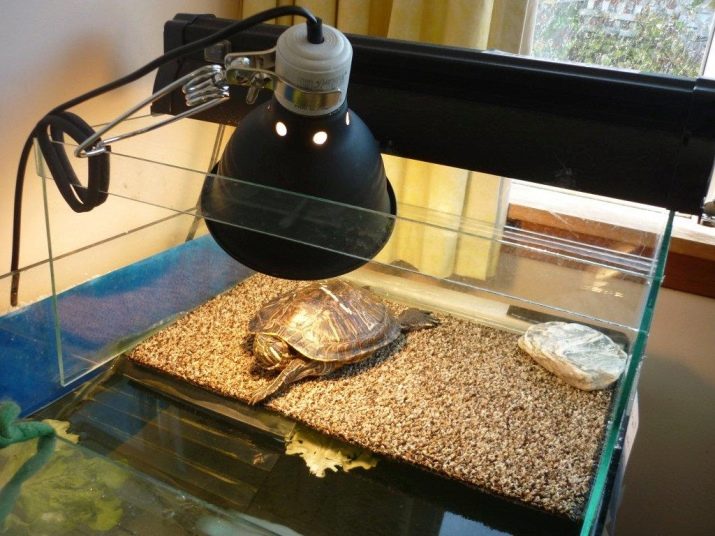
In addition, turtles need to turn off the lights at night.
You need to install filters that will allow you to purify the water and get rid of the smell in the aquarium. They can be both internal and external. The first of them are small in size, and are also equipped with pumps and a diffuser. Such filters do an excellent job of purifying water. The second in their appearance resemble a small canister with a pump, which is taken out of the aquarium. Such a filter is connected to water by pipes. In addition, it is necessary several times a year to do a general cleaning of the aquarium, thoroughly cleaning it.

Breeding
Domestic reptiles breed well in captivity. Females regularly lay eggs, but they can also be unfertilized. For full reproduction, of course, you need two heterosexual turtles. At home, reptiles mate most often from February to May. In addition, you can slightly stimulate the beginning of their mating. To do this, slightly increase the temperature.
Before starting, the male is very interestingly caring for his “lady”. He begins to swim in front of her tail forward, then tickles her cheeks with his claws. Sometimes males begin to hit the female with their shell on the shell. If the female is ready for mating, then she allows her chosen one to come to her. This usually happens in water and lasts no more than 15 minutes. This is enough to lay 4 to 5 egg laying.
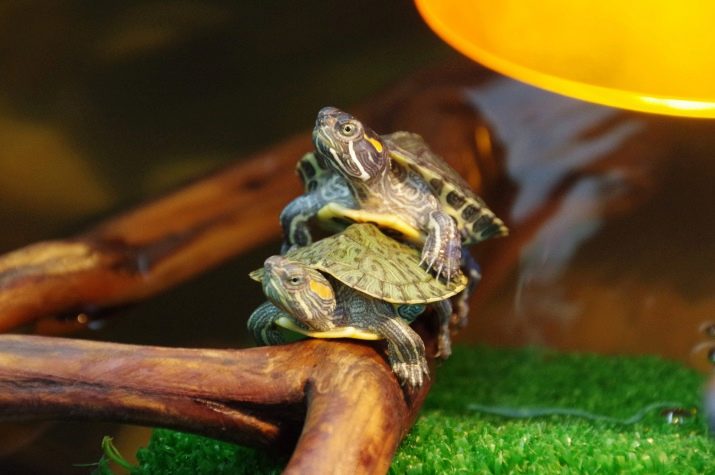
Sperm can be present in the genitals of a reptile for up to two years.
In the natural environment, the tortoise begins to lay eggs from the beginning of April. The laying lasts until September. First, it moistens sand with its liquid, then digs a hole up to 20 centimeters in diameter. After that, lay 5 to 15 eggs in it and fill them with sand. For the reptile to do this in the aquarium, you need to make an artificial beach for it. To do this, place in it a cuvette with slightly moistened sand, the layer of which will not exceed more than 5 centimeters. So that the turtle could easily climb there, you need to make a special ladder and carefully attach it to the cuvette.
If the reptile laid eggs directly in the water, they should be immediately removed from there and put in the sand. Most often, experts recommend buying a separate aquarium for mating. Its volume should not be less than 100 liters, and water fill it by about 10 centimeters. The mating process and its consequences must be monitored. The future of posterity depends on this. If pairing does not occur, then the pair needs to be seated separately and only after a while again repeat pairing.
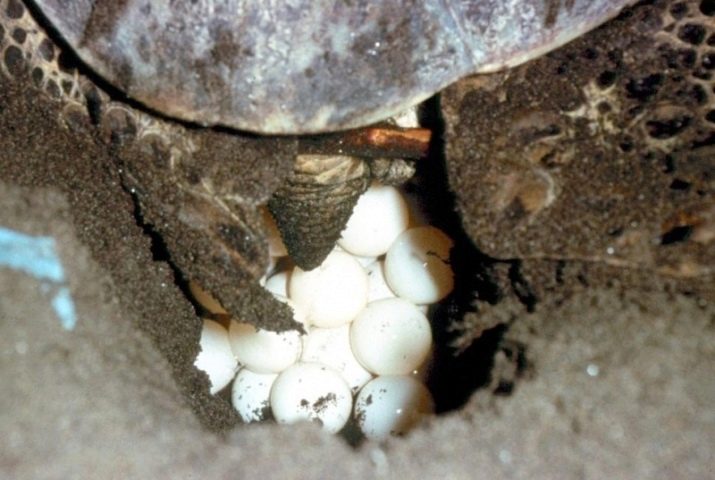
Fish compatible
A very important issue is the compatibility of reptiles with other aquarium inhabitants. They may not get along with everyone.It is not necessary to settle small fish in a container with turtles, because these reptiles are considered predators and immediately eat them. This is especially true for red-eared and swamp turtles. Besides, they will need a special plot with "land", which is completely unnecessary for other aquatic inhabitants.
Aquarium turtles can be kept together with large fish. It can be American cichlids, catfish or even carps, or other large fish. Two-clawed tailed aquatic turtles will be able to get along in the same aquarium with such fish. They feed mainly on vegetation and squid meat. In addition, this kind of reptile islet in the aquarium is completely unnecessary.
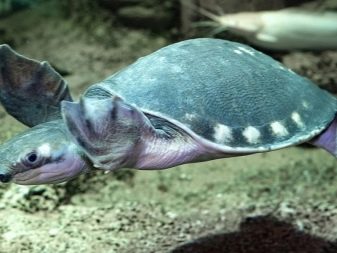

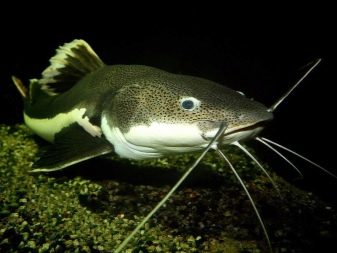
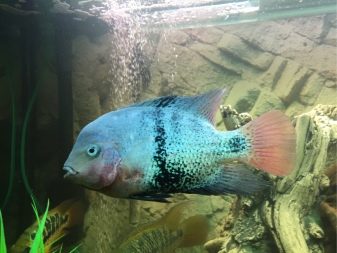
Even reptiles such as turtles will live well at home. The only thing they need is proper care, as well as ideal conditions for their maintenance.
See how to care for turtles in the video below.
